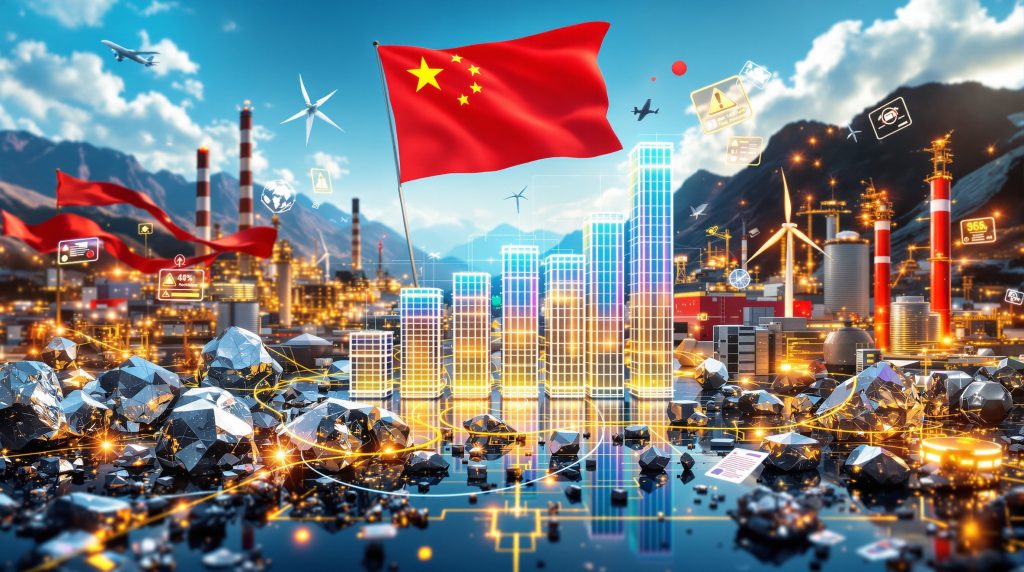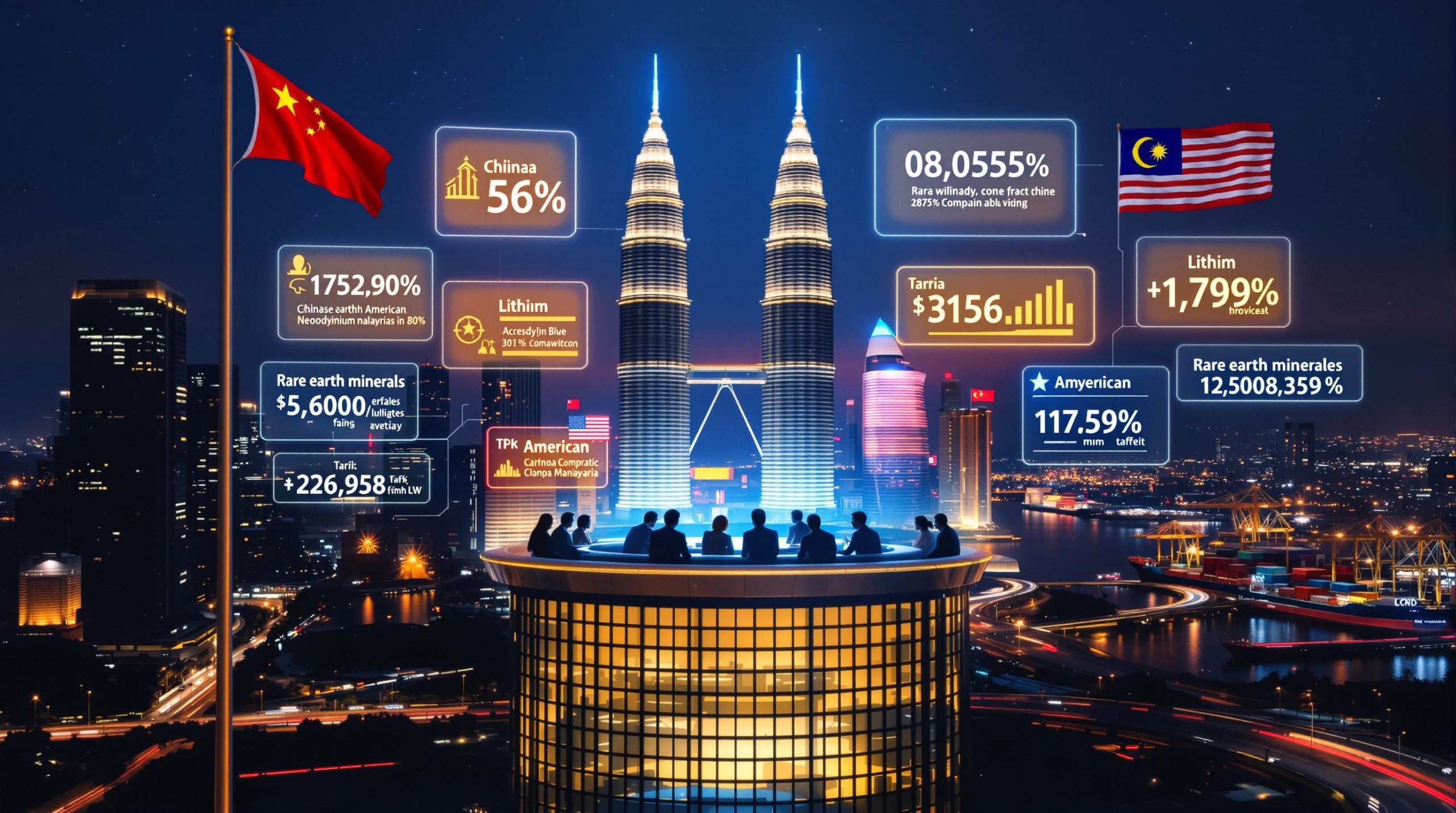China has implemented comprehensive export licensing requirements for critical rare earth elements, fundamentally reshaping global supply chain dynamics and creating unprecedented leverage in international trade negotiations. These measures represent a significant escalation in Beijing's resource diplomacy strategy, targeting materials essential for defense systems, renewable energy technologies, and advanced manufacturing across multiple industries. The critical minerals energy transition has become increasingly vulnerable to these geopolitical tensions.
The new framework establishes mandatory licensing protocols for rare earth exports, with China Rare Earth Group publicly committing to strictly enforce government guidance on these controls. This state-owned conglomerate, formed in 2021, has designated regulatory compliance as a key operational focus, signaling robust implementation of the export restrictions despite international criticism.
Understanding the Scope of China's 2025 Export Licensing System
The export licensing system operates through a centralized approval mechanism that requires manufacturers and traders to obtain specific permits before shipping rare earth materials internationally. This bureaucratic layer creates potential delays and uncertainties for global supply chains that have historically relied on uninterrupted access to Chinese rare earth supplies.
Economic analysis suggests these controls represent long-term policy commitments rather than temporary negotiating tactics. According to research from the University of International Business and Economics in Beijing, the measures will not be reversed regardless of external pressure, though implementation flexibility may emerge through streamlined approval procedures or supply chain stability commitments depending on trade negotiation outcomes.
The Strategic Elements Under Beijing's Control Framework
The licensing requirements encompass both raw rare earth materials and processed products, creating comprehensive oversight of the entire value chain. This includes rare earth oxides, alloys, and permanent magnets that form critical components in wind turbines, electric vehicle motors, and precision-guided defense systems.
Manufacturing sectors face particular vulnerability due to their dependence on specific rare earth grades and purities. The electronics industry relies heavily on refined rare earth compounds for display technologies and semiconductor applications, while aerospace manufacturers require specialised alloys for high-performance components operating under extreme conditions.
Extraterritorial Reach: How China's Rules Apply Beyond Its Borders
Perhaps most significantly, these export controls extend beyond China's borders through extraterritorial enforcement mechanisms. Products manufactured outside China using Chinese rare earth materials or technology transfer arrangements may still require export licenses, creating complex compliance obligations for multinational corporations.
This global reach forces companies to evaluate their entire supply chain architecture, not just direct sourcing relationships with Chinese suppliers. Third-party manufacturers, joint venture partners, and technology licensing agreements all potentially fall under the scope of these regulations, requiring comprehensive legal and operational assessments.
Critical Materials Facing Export Restrictions Under China's Framework
The export control framework targets approximately twelve rare earth elements critical to modern technological applications. These materials span both light and heavy rare earth categories, each serving distinct industrial purposes and presenting different supply chain challenges for dependent industries.
Light Rare Earth Elements and Their Strategic Applications
Light rare earth elements, including cerium, lanthanum, and neodymium, form the foundation of numerous consumer and industrial applications. Cerium serves as a polishing compound for precision optics and catalytic converter components, while lanthanum enables high-capacity battery electrodes and optical glass formulations.
Neodymium represents perhaps the most strategically significant light rare earth, providing the magnetic properties essential for permanent magnet motors in electric vehicles and wind turbines. The automotive industry's transition toward electrification creates exponentially growing demand for neodymium-based magnets, making supply security a critical competitive advantage.
Heavy Rare Earth Elements and Advanced Technology Dependencies
Heavy rare earth elements, including dysprosium, terbium, and gadolinium, command premium prices due to their scarcity and specialised applications. Dysprosium enhances the temperature stability of permanent magnets, enabling operation in high-heat environments such as automotive traction motors and industrial automation systems.
Terbium serves essential functions in solid-state lighting and display technologies, while gadolinium enables magnetic resonance imaging systems and neutron capture applications in nuclear reactors. These elements often represent single-source dependencies for critical applications, creating vulnerability points in defence supply chain crisis scenarios.
Advanced Manufacturing Components Under Control
Beyond raw materials, the export controls encompass processed products including sintered magnets, metal alloys, and specialised compounds. This comprehensive approach prevents circumvention through intermediate processing stages and maintains Chinese oversight throughout the value chain.
| Material Category | Specific Elements/Products | Strategic Applications |
|---|---|---|
| Light REEs | Cerium, Lanthanum, Neodymium | Catalysts, Batteries, Magnets |
| Heavy REEs | Dysprosium, Terbium, Gadolinium | High-Temperature Magnets, Medical Devices |
| Processed Products | Sintered Magnets, Alloys, Oxides | Automotive, Aerospace, Electronics |
Global Supply Chain Vulnerabilities Created by Export Controls
The implementation of comprehensive rare earth export controls exposes fundamental weaknesses in globalised manufacturing systems that evolved assuming unrestricted access to Chinese materials. Industries with limited supplier diversity face immediate operational risks, while sectors requiring specific rare earth grades confront potential production bottlenecks.
Defense and Aerospace Industry Exposure Levels
Military contractors maintain particularly acute vulnerability due to their reliance on specialised rare earth compounds for guidance systems, radar technologies, and electronic warfare applications. Fighter aircraft engines require heat-resistant rare earth alloys, while precision-guided munitions depend on rare earth-based sensors and communications systems.
The defence industrial base faces extended lead times for alternative sourcing due to rigorous qualification requirements and security clearance protocols. Transitioning to non-Chinese suppliers often requires years of testing and certification, creating potential capability gaps during geopolitical tensions when military readiness becomes paramount.
Automotive Sector Dependencies on Chinese Processing
Electric vehicle manufacturers face immediate challenges due to their dependence on rare earth permanent magnets for traction motors and charging infrastructure. Tesla, General Motors, and European automakers source significant portions of their magnet materials from Chinese suppliers, creating potential production disruptions if export licenses face delays or denials.
The automotive industry's just-in-time manufacturing philosophy compounds these vulnerabilities, as companies maintain minimal inventory buffers to optimise working capital. Extended licensing approval timelines could force production line shutdowns and delivery delays, particularly affecting premium electric vehicle models that rely heavily on rare earth-intensive components.
Electronics Manufacturing Supply Chain Bottlenecks
Consumer electronics manufacturers face broad exposure across product categories, from smartphones requiring rare earth-based speakers and vibration motors to laptops utilising rare earth phosphors in display backlighting systems. The complexity of modern electronics creates multiple vulnerability points within single products.
Critical Supply Chain Insight: The extraterritorial enforcement of export controls means that electronics assembled in Southeast Asia using Chinese rare earth components still require export licenses, creating unprecedented supply chain complexity that extends far beyond direct China-based manufacturing relationships.
Geopolitical Triggers Behind China's Export Control Expansion
China's decision to expand rare earth export controls reflects calculated responses to escalating technology restrictions and trade tensions initiated by Western governments. These measures represent strategic retaliation designed to leverage China's resource dominance while creating negotiating advantages in broader economic disputes.
Retaliation Against Western Technology Restrictions
The timing of rare earth export controls coincides with intensifying restrictions on Chinese access to advanced semiconductor technologies, artificial intelligence systems, and quantum computing components. Western governments have implemented increasingly sophisticated export controls targeting Chinese technology companies, prompting Beijing to respond with its own resource-based restrictions.
This tit-for-tat escalation demonstrates how critical material dependencies create mutual vulnerabilities in interconnected global supply chains. While Western countries restrict China's access to cutting-edge technologies, China controls the raw materials necessary to manufacture those same technologies, creating complex strategic interdependencies.
Strategic Response to U.S. Tariff Escalations
Trade tensions have intensified significantly, with Trump's critical order expected to influence future negotiations. The rare earth export controls provide Beijing with substantial leverage entering high-stakes discussions regarding trade and technology disputes.
Furthermore, China has tightened its grip on critical mineral exports, creating additional complexity for global supply chains. The scheduling of high-level diplomatic meetings immediately following the announcement of expanded export controls indicates coordinated strategy.
Leveraging Market Dominance in International Negotiations
Beijing's strategy capitalises on decades of investment in rare earth mining, processing, and refining capabilities that created global market dominance. While other countries possess rare earth deposits, China controls approximately 85-90% of global processing capacity, creating bottlenecks that cannot be easily circumvented through alternative sourcing.
This processing monopoly represents the true source of Chinese leverage, as raw rare earth ores require sophisticated separation and purification techniques to produce materials suitable for high-technology applications. Even if alternative mines increase production, they remain dependent on Chinese processing facilities to create usable end products.
Industries Facing Severe Risk from Rare Earth Restrictions
The breadth of industries dependent on rare earth materials creates widespread economic exposure to China rare earth export controls. Sectors with high rare earth intensity, limited supplier alternatives, and long qualification cycles face the most immediate and severe operational risks.
Defense Contractors and Military Equipment Manufacturers
Military applications represent the highest-stakes sector affected by rare earth restrictions, as defence capabilities directly impact national security interests. Advanced weapon systems, including fighter jets, naval vessels, and missile defence installations, incorporate rare earth-based components throughout their designs.
Specific vulnerabilities include:
- Radar and electronic warfare systems requiring terbium and europium for signal processing
- Jet engine components utilising heat-resistant rare earth alloys for turbine blades
- Guidance systems depending on rare earth-based sensors and magnets for precision targeting
- Communications equipment incorporating rare earth phosphors and magnetic materials
The defence sector's qualification requirements create extended timelines for supplier transitions, potentially lasting three to five years for critical components. This extended vulnerability window creates strategic risks during periods of heightened geopolitical tensions.
Renewable Energy Technology Producers
Wind turbine manufacturers face immediate challenges due to their dependence on massive permanent magnets containing neodymium and dysprosium. A typical 3-megawatt wind turbine requires approximately 200 kilograms of rare earth materials, making supply security essential for renewable energy deployment targets.
Solar panel manufacturers also face exposure through rare earth-based inverter components and tracking systems, though to a lesser degree than wind power applications. The renewable energy industry's rapid growth compounds these supply pressures, as expanding installation targets require proportionally increasing rare earth supplies.
Consumer Electronics and Semiconductor Companies
Technology companies face multifaceted exposure across their product portfolios, from rare earth-based permanent magnets in smartphone speakers to europium-based phosphors in display technologies. The miniaturisation of electronic components often requires specialised rare earth compounds with precise chemical compositions.
However, the IEA notes that export controls create reality of supply concentration risks that were previously theoretical concerns for manufacturers worldwide.
Corporate Adaptation Strategies for Export Control Compliance
Global companies are implementing comprehensive supply chain restructuring initiatives to address rare earth export control risks. These adaptations range from immediate inventory management adjustments to long-term supplier diversification investments requiring substantial capital commitments and extended implementation timelines.
Stockpiling Strategies and Inventory Management Approaches
Manufacturers are dramatically increasing rare earth inventory levels to buffer against potential export license delays or supply disruptions. This strategic stockpiling requires significant working capital investments and specialised storage capabilities for chemically reactive rare earth compounds.
Inventory strategies focus on critical bottleneck materials rather than comprehensive rare earth stockpiling, as storage costs and chemical stability concerns limit practical inventory durations. Companies prioritise heavy rare earth elements like dysprosium and terbium, which command premium prices and face the most severe supply constraints.
Supply Chain Diversification Initiatives Beyond China
Long-term adaptation strategies emphasise supplier diversification through partnerships with non-Chinese rare earth producers and processors. However, implementation faces substantial challenges due to limited alternative processing capacity and extended qualification requirements for aerospace and defence applications.
Diversification efforts concentrate on:
- North American supply chains utilising Mountain Pass mining operations and domestic processing initiatives
- Australian partnerships leveraging Lynas Rare Earths processing capabilities
- European strategic alliances supporting EU critical materials independence objectives
- Recycling technologies reducing primary rare earth demand through secondary recovery systems
Technology Transfer Restrictions and Compliance Challenges
Companies face complex compliance obligations due to the extraterritorial reach of China rare earth export controls, requiring comprehensive legal analysis of joint ventures, licensing agreements, and technology sharing arrangements. These assessments often reveal unexpected exposure through indirect relationships and third-party suppliers.
Implementation flexibility may emerge through streamlined approval procedures or supply chain stability commitments, depending on foreign trade negotiation progress. This potential flexibility creates opportunities for proactive engagement with Chinese authorities to secure favourable licensing treatment.
Alternative Rare Earth Sources Outside China
Development of non-Chinese rare earth supply chains represents a critical strategic priority for import-dependent countries, though significant challenges remain in scaling alternative production to meet global demand. Current projects face financing constraints, environmental permitting delays, and technical hurdles in developing processing capabilities.
North American Rare Earth Development Projects
The United States has prioritised rare earth supply chain resilience through both private sector investments and government funding initiatives. Mountain Pass in California represents the primary domestic mining operation, while several development-stage projects aim to expand North American production capacity.
Key North American projects include:
- Mountain Pass (California): Currently producing rare earth concentrates with plans for expanded downstream processing
- Bokan Mountain (Alaska): Advanced-stage heavy rare earth development project targeting dysprosium and terbium
- Bear Lodge (Wyoming): Integrated mining and processing facility targeting light rare earth production
- Round Top (Texas): Unique deposit containing both rare earths and lithium for battery applications
Australian Mining Operations and Processing Capabilities
Australia has established the most advanced non-Chinese rare earth processing capabilities through Lynas Rare Earths' operations in Western Australia and Malaysia. This processing capacity provides a foundation for expanded production to serve global markets outside Chinese control.
Australian developments focus on:
- Mount Weld operations producing mixed rare earth carbonate for downstream processing
- Nolans Project in Northern Territory targeting integrated mining and processing
- Government strategic partnerships supporting critical minerals supply chain development
- Technology development for sustainable rare earth separation and purification processes
The Australia strategic reserve initiatives complement these private sector developments, creating comprehensive supply security frameworks.
European Union Strategic Autonomy Initiatives
The European Union has launched comprehensive programmes to reduce rare earth import dependence through domestic resource development, recycling initiatives, and strategic partnerships with allied countries. These efforts aim to achieve supply chain resilience for critical technology applications.
| Region | Key Projects | Production Capacity | Timeline to Market |
|---|---|---|---|
| North America | Mountain Pass, Bokan Mountain | 15,000+ tonnes REO annually | 2025-2027 |
| Australia | Mount Weld, Nolans Project | 20,000+ tonnes REO annually | 2025-2028 |
| Europe | Kvanefjeld, Norra Kärr | 5,000+ tonnes REO annually | 2027-2030 |
Note: Production capacity figures represent rare earth oxide (REO) equivalent and timelines are subject to regulatory approvals and financing completion.
Economic Implications of China's Rare Earth Strategy
The implementation of comprehensive export controls creates significant economic disruptions across global rare earth markets, generating price volatility, supply chain restructuring costs, and strategic investment shifts toward alternative suppliers. These economic impacts extend far beyond immediate supply disruptions to reshape long-term industrial competitiveness.
Price Volatility and Market Manipulation Concerns
Rare earth prices exhibit extreme sensitivity to supply disruption concerns, with historical precedent from China's 2010 export restrictions demonstrating potential for 500-1000% price increases within months. Current export controls create similar price pressures, particularly for heavy rare earth elements with limited alternative supply sources.
Market dynamics are further complicated by the opacity of rare earth pricing mechanisms and the concentration of trading activity among Chinese state-owned enterprises. This market structure enables coordinated pricing strategies that amplify the economic impact of export restrictions on dependent industries.
Investment Flows into Alternative Supply Chain Development
Rare earth export controls are catalysing substantial private and government investment in alternative supply chain development. Venture capital and strategic investors are allocating billions of dollars toward rare earth mining, processing, and recycling technologies to reduce Chinese dependence.
Investment priorities include:
- Mining project development in North America, Australia, and Africa
- Processing technology advancement for sustainable rare earth separation
- Recycling infrastructure to recover rare earths from end-of-life products
- Strategic stockpile development by government and industry partnerships
Long-term Costs of Supply Chain Restructuring
Supply chain diversification requires substantial capital investments and extended implementation timelines that create significant economic burdens for dependent industries. Automotive manufacturers estimate spending hundreds of millions of dollars to secure alternative rare earth supplies and redesign products to reduce material intensity.
These restructuring costs ultimately translate into higher consumer prices and reduced profit margins across affected sectors. The economic burden is particularly acute for smaller companies lacking the financial resources to implement comprehensive supply chain alternatives.
Western Government Response Strategies to Export Controls
Western governments are developing multifaceted response strategies combining trade policy measures, strategic material stockpiling, and international cooperation frameworks to address rare earth supply vulnerabilities. These responses aim to reduce Chinese leverage while avoiding escalatory trade conflicts.
Potential Retaliatory Trade Measures and Tariff Escalations
The European Union is actively weighing countermeasures in response to China's rare earth export controls, though specific proposals remain under development. These potential responses could include targeted tariffs on Chinese rare earth products or restrictions on Chinese access to European technology and investment opportunities.
Retaliation strategies face the fundamental challenge that China controls critical supply chains, limiting the effectiveness of traditional trade policy tools. Western countries risk economic self-harm through aggressive retaliation that could provoke further Chinese restrictions on essential materials.
Strategic Reserve Building and Government Stockpiling Programs
Government stockpiling initiatives are expanding rapidly to provide supply security buffers during geopolitical tensions or trade disputes. The United States National Defense Stockpile and similar programmes in allied countries are increasing rare earth inventory targets and diversifying supplier relationships.
Stockpiling strategies prioritise:
- Heavy rare earth elements with the most severe supply constraints
- Defence-critical materials essential for weapon system production
- Processed rare earth products ready for immediate industrial use
- Strategic partnerships with allied rare earth producers for supply security
International Cooperation Frameworks for Critical Mineral Security
Multilateral cooperation initiatives are emerging to coordinate rare earth supply chain development among allied countries. The Minerals Security Partnership and similar frameworks aim to pool resources and expertise to develop alternative suppliers outside Chinese control.
Policy Consideration: The European Union is actively evaluating countermeasures while the U.S. considers additional tariffs, potentially escalating the trade conflict beyond rare earths into broader economic sectors including technology transfer, financial services, and agricultural products.
Future Trade Relations Under China's Export Control Strategy
China rare earth export controls represent a fundamental shift toward resource-based economic leverage that will permanently alter international trade relationships. These measures establish precedents for using critical material dependencies as diplomatic tools, potentially inspiring similar strategies from other resource-rich countries.
Rare Earths as Diplomatic Leverage in International Negotiations
The strategic use of rare earth controls demonstrates how resource dominance can substitute for traditional military or economic pressure in international relations. Beijing's near-monopoly position in rare earth supply and processing provides substantial bargaining power in discussions covering trade, technology transfer, and strategic competition.
This diplomatic strategy demonstrates how resource control can create negotiating advantages in broader economic disputes. Countries with critical material dependencies must balance economic interests with geopolitical autonomy when engaging with dominant suppliers.
Technology Transfer Restrictions and Innovation Impacts
Export controls create complex implications for international technology collaboration, as joint research projects and licensing agreements may fall under Chinese regulatory oversight. This expanded scope could limit innovation partnerships and slow technological advancement in affected sectors.
The long-term policy commitment to rare earth controls suggests permanent changes in technology transfer protocols rather than temporary negotiating tactics. Companies must adapt to sustained regulatory complexity when engaging with Chinese partners or suppliers.
Long-term Implications for Global Supply Chain Architecture
The weaponisation of rare earth supplies accelerates the fragmentation of global supply chains along geopolitical lines, creating parallel economic systems that reduce efficiency but increase supply security. This structural shift reverses decades of globalisation trends toward integrated international manufacturing networks.
Future supply chain architectures will likely emphasise strategic autonomy over cost optimisation, with companies accepting higher production costs in exchange for reduced geopolitical risk exposure. This transformation represents a fundamental rebalancing of economic priorities in an increasingly multipolar world.
Navigating Complex Chinese Licensing Requirements
Companies operating in rare earth supply chains must develop sophisticated compliance capabilities to navigate China's export licensing system effectively. Success requires understanding bureaucratic procedures, maintaining regulatory relationships, and implementing comprehensive documentation systems to ensure approval success.
Understanding the Export License Application Process
The licensing application process involves multiple government agencies and requires detailed documentation of end-use applications, customer relationships, and technology specifications. Applications must demonstrate compliance with Chinese national security interests and foreign policy objectives to secure approval.
China Rare Earth Group has identified regulatory compliance as a key operational focus for the fourth quarter, indicating rigorous enforcement of licensing requirements. This state-owned enterprise's commitment to strict compliance suggests comprehensive government oversight of the licensing system.
Compliance Strategies for Multinational Corporations
Multinational corporations require dedicated legal and regulatory teams to manage Chinese export control compliance across their global operations. These teams must monitor regulatory changes, maintain government relationships, and coordinate compliance activities across multiple jurisdictions.
Effective compliance strategies include:
- Legal expertise in Chinese trade and investment regulations
- Government relations capabilities for regulatory engagement
- Documentation systems for comprehensive licensing application support
- Risk assessment frameworks for evaluating compliance exposure
Risk Management Approaches for Critical Material Dependencies
Companies must implement comprehensive risk management systems that account for both regulatory compliance requirements and operational supply chain risks. These systems integrate legal, operational, and strategic planning capabilities to maintain business continuity despite export control uncertainties.
Implementation flexibility may emerge through streamlined approval procedures or supply chain stability commitments, depending on the progress of foreign trade negotiations. This potential flexibility creates opportunities for proactive engagement with Chinese authorities to secure favourable licensing treatment.
Investment Considerations for Rare Earth Market Dynamics
The rare earth market presents complex investment opportunities shaped by geopolitical tensions, supply chain restructuring, and technological innovation. Investors must balance potential returns from supply shortage premiums against regulatory risks and long-term market evolution toward alternative suppliers.
Investment Opportunities in Non-Chinese Rare Earth Projects
Alternative rare earth projects outside China attract substantial investment interest due to strategic value and potential supply shortage premiums. However, these investments face significant technical, environmental, and financial challenges that create substantial execution risks.
Investment criteria for rare earth projects emphasise:
- Geological resource quality and extraction feasibility
- Processing technology capabilities and environmental compliance
- Government support through strategic partnerships and financing
- End-user relationships providing demand security and pricing power
For comprehensive guidance on navigating these complex market dynamics, investors should consult the investing guide 2025 to understand broader strategic frameworks.
Risk Assessment for Rare Earth-Dependent Industries
Industries with high rare earth exposure face valuation discounts reflecting supply chain vulnerability and restructuring costs. Investment analysis must account for both immediate operational risks and long-term competitive implications of supply chain adaptation strategies.
Sector-specific risk factors include:
- Defence contractors: National security implications and government support
- Renewable energy: Growth prospects versus supply chain constraints
- Consumer electronics: Margin pressures and alternative technology adoption
- Automotive: Electric vehicle transition dependencies and timeline risks
Market Outlook for Alternative Supply Chain Development
Long-term rare earth market dynamics favour geographic diversification and processing capacity development outside China, creating investment opportunities in mining, processing, and recycling technologies. However, market development timelines extend 5-10 years for most alternative supply projects.
Investment themes supporting rare earth supply chain transformation include advanced separation technologies, sustainable mining practices, and strategic material recycling systems. These technologies address both supply security concerns and environmental sustainability requirements driving industry evolution.
Investment Disclaimer: The rare earth market involves significant geopolitical, technical, and market risks that can result in substantial losses. Investors should conduct comprehensive due diligence and consider professional investment advice before making rare earth-related investment decisions. Past performance and geological assessments do not guarantee future returns or project success.
China rare earth export controls represent a strategic inflection point in global supply chain management, forcing industries and governments to reevaluate critical material dependencies and develop alternative sourcing strategies. The long-term implications extend far beyond immediate supply disruptions to reshape international trade relationships and industrial competitiveness in strategic technology sectors. Success in navigating this transformed landscape requires comprehensive understanding of regulatory requirements, supply chain alternatives, and the geopolitical dynamics driving these fundamental market changes.
Looking to Capitalise on Critical Mineral Supply Chain Disruptions?
Discovery Alert's proprietary Discovery IQ model delivers real-time alerts on significant ASX mineral discoveries, helping investors identify opportunities in critical materials sectors before supply chain tensions create market volatility. With China's rare earth export controls reshaping global supply chains, understanding which companies are developing alternative sources becomes crucial for strategic positioning. Explore Discovery Alert's discoveries page to see how historic mineral discoveries have generated substantial returns, then begin your 30-day free trial to gain immediate access to emerging opportunities in this rapidly evolving market.




